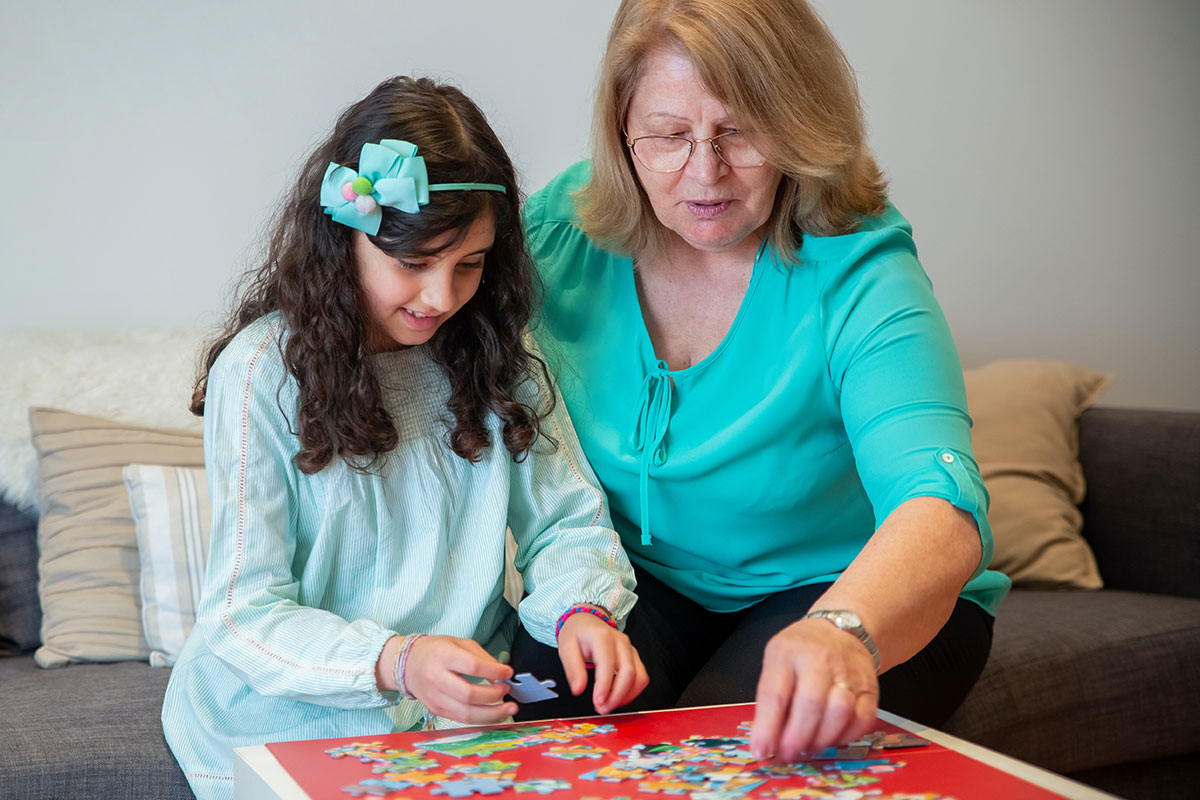Supporting Someone with Autism
If you have a child, an adolescent, or an adult who has just been diagnosed with Autism Spectrum Disorder (ASD), you may be feeling overwhelmed and seeking guidance as to how best to support your loved one.
The best way to support someone with autism is:
- Be patient and use clear, direct communication.
- Respect their sensory sensitivities and create a sensory friendly environment.
- Establish predictable routines and maintain consistency.
- Respect their personal space and their comfort levels with physical contact.
- Recognise their neurodiversity and celebrate the different perspectives they offer.
To support someone with Autism Spectrum Disorder, learn as much as you can about the condition and the person’s triggers. Sticking to regular schedules, providing a safe and secure environment, learning how to communicate nonverbally, and paying attention to sensory sensitivities can help you to support them to live a healthy and happy life.
How to Support or Help Someone with Autism?
We all want the people we love to live the best life possible, and with your love and support, some education, and other support systems available, there’s no reason that they can’t live a prosperous and happy life.
First of all, if you believe your child may have ASD, the best thing you can do is to seek professional advice as soon as possible. A proper diagnosis can take time, but the most successful interventions are implemented during the early years; delaying treatment might impact the eventual quality of life of your child or loved one.
Treatment is not solely the act of providing medications; therapies, support systems, education, and certain coping strategies can help you to ease your loved one into a more comfortable and fulfilling lifestyle if they are living on the autism spectrum.
Learn about autism
The more clued up you are about autism spectrum disorder, the better equipped you’ll be to support your loved one. Educate yourself about treatment options, coping strategies, and find out as much as you can about their personal experience with the condition. Don’t be afraid to ask your loved one and the medical and support professionals they work with questions.
Identify their triggers
Understanding why your loved one exhibits certain behaviours is an important part of supporting them. Learn what activities or environments trigger your loved one’s challenging behaviours and what elicits a positive response; what makes them comfortable, happy, and calm and what they may find uncomfortable, stressful, or even frightening. By understanding what affects them, you’ll be well prepared to troubleshoot problems and prevent or modify circumstances to ensure your loved one can feel at ease.
Provide consistent structure and safety
People with ASD need and sometimes even crave consistency. Be consistent with techniques in school, work, while out and about, and at home. Creating consistency is the best way to reinforce learning. Children with ASD sometimes have a hard time applying what they’ve learned in one setting when they’re confronted with other circumstances. Therefore, consistency in your interaction and the way you deal with challenging behaviours helps avoid any confusion.
Due to that need for consistency, children with ASD generally perform the best when they stick to a highly structured schedule or routine. Make eating and sleeping times regular and, if possible, schedule regular therapies or other regular activities at the same time each week. Try to keep disruptions to their schedule to a minimum and, if you are aware of a schedule change in advance, prepare you and your loved one to help mitigate any negative repercussions.
Reward good behaviour
Positive reinforcement can be a game changer for children with ASD. Praise them when they act appropriately or learn a new skill and be very specific about what behaviour they are being praised for. You can incorporate other ways to reward good behaviour such as letting them play with their favourite toy or creating a star sticker chart.
Find non-verbal ways to communicate
It can be challenging to connect with children with ASD. You need to learn their preferred language, and be observant to their nonverbal cues that they may use to communicate. To determine if they are tired, hungry, or want something else, you can learn the sounds they make, their facial expressions, and gestures. They in turn can learn the ways you communicate which can be through the tone of your voice, the way you look at them, or your body language.
If you miss their nonverbal communication techniques, they may feel misunderstood or ignored which can lead to them becoming upset. When children with ASD act out, it’s often because people are not picking up on their nonverbal cues. Figure out the motivation behind the tantrum; it may be their way of communicating their frustration and gaining your attention.
Make time for fun
Play is an essential part of learning. But in addition to learning, spending unpressured time between you and your loved one can help you build a bond between you. Find ways to have fun together by analysing what makes them smile, laugh, and come out of their shell. For the greatest impact, schedule fun time or play time when they are most alert.
Pay attention to sensory sensitivities
Many people on the autism spectrum have hypersensitive senses and may have a heightened reaction to light, sound, smells, or movements. Figure out which sensations trigger your loved one and in what way. It can be a positive or negative response, so find out what senses trigger their disruptive behaviours and what causes them to be calm or happy. This will help you to prepare for, prevent, or even encourage these situations where their senses may trigger positive or negative behaviours.
What are Common Symptoms of Autism Spectrum Disorder?
The signs and symptoms of autism spectrum disorder fall under three main categories:
- Verbal and nonverbal communication
- Social interaction
- Repetitive or ritualistic behaviour
Each person’s experience with ASD will be different and there will be varying symptoms including possibly a mixture of some or all of the above. There are specific clinical criteria that must be met to make a diagnosis of ASD, but that’s also why ASD is considered to have a spectrum.
What is the Four Stage Approach For Autism?
Identification
Identifying is the first step to addressing a symptom. By characterising and identifying a behaviour or a trigger, you can determine the tools and strategies you’ll eventually need to deal with it.
Understanding
Identifying the communication behind the behaviour, why a certain trigger makes your loved one react the way they do, what are their needs and desires, and what do they need to communicate. By understanding the behaviour along with the trigger, we can learn how to avoid episodes and practise coping mechanisms to deal with them when they do arise.
Management
Work with your medical professionals to develop a treatment and management plan; this could involve certain forms of therapy or types of skills development. An applied behaviour analysis can help people with autism to learn new and effective behaviours. Some forms of medication can also help to mitigate symptoms and behaviours.
Prevention
Prevent symptoms by creating calming, predictable, and rewarding environments. Structured schedules and routines can be helpful, including with visual timetables which help to smooth transitions between activities. You can also provide tools to mitigate overwhelming feelings.
Supporting children with autism
Supporting children with autism involves creating a nurturing and inclusive environment that recognises their unique strengths and challenges. Learn to understand your child’s specific needs and their communication style. Be patient, use clear communication, and respect their sensory sensitivities.
You can tailor their education and social interactions to support their comfort level, as well as provide structured routines and help them discover new ideas and hobbies they may be interested in. Ultimately, the best way to support children with autism is to always be encouraging and compassionate. They have so much potential to bring new ideas and perspectives into the world, and with your love and support they have the potential to truly thrive.
What kind of support do autistic adults need?
Although ASD is often diagnosed in young children, the symptoms can become more apparent in adulthood. Due to the amount of support there is for children with ASD while they’re at school or even at home with their families, adults with ASD may feel isolated in comparison. It can be difficult to juggle the demands of adult life while navigating their symptoms and their consequences.
Adults with ASD may struggle with:
- Difficulty interpreting body language and facial expressions;
- Difficulty picking up on social cues;
- Inability to comprehend empathy for others or ‘put themselves in someone else’s shoes’;
- Trouble dealing with changes in schedule or routine;
- Difficulty developing relationships with others;
- Tendency towards repetitive behaviours;
- Deep interest in specific topics;
- Inability to make eye contact when conversing with others;
- Difficulty accepting feedback or corrections from others;
Adults with ASD may struggle with interacting socially or day to day tasks such as a supermarket shop. They may struggle in certain work environments but thrive in others.
The good news is that there are government funded supports for adults with ASD and Maple Community Services are very well versed in helping you connect with those supports; this can enable you to achieve your life goals without having to make sacrifices. Get in touch with us to know how you can benefit from NDIS funding.
What is the Most Effective Therapy for Autism?
If you suspect you or your loved one may have ASD, then early intervention is paramount to successful treatment and the best possible outcomes. The most effective type of therapy for those with Autism Spectrum Disorder are behavioural therapies based on Applied Behavioural Analysis (ABA).
With ABA therapies, the emphasis is put on reinforcing behaviours that form the foundation of skill development. It breaks down each complex behaviour into a series of smaller tasks to enable an individual’s learning. It aims to promote social development, development of daily life skills, and redirects harmful behaviours such as self injury. It can also teach an individual new skills and help them to apply them to new and real life scenarios.
Other beneficial therapeutic options include occupational therapy, speech therapy, physical therapy, and pharmacological therapy. Treatments in the form of therapies aim to minimise the impact of symptoms and maximise an individual’s functional independence and quality of life.
How do you motivate someone with autism?
For people who live with ASD, motivation can be one of the main obstacles to leading a full and happy life. Everyday activities such as learning, social activities, and completing everyday tasks can be challenging. We can help to motivate our loved ones with ASD by:
- Addressing them with dignity – don’t treat them any less than you would anyone else.
- Follow a direct communicative approach – don’t ‘beat around the bush’ as this can be confusing.
- Create and stick to a consistent schedule – don’t cancel on them last minute.
- Learn more about their condition so you can understand what their triggers may be.
If you’re seeking comprehensive support, exploring available NDIS plan management services can provide valuable assistance. There are many things you can do to support someone with Autism Spectrum Disorder. While it is true that ASD is not something that simply goes away, if you want to help them overcome their challenges, then we have a few tips that can help.
If you would like to learn more about the supports available to you and your loved one through the NDIS, reach out to us at Maple Community Services and get started today.


